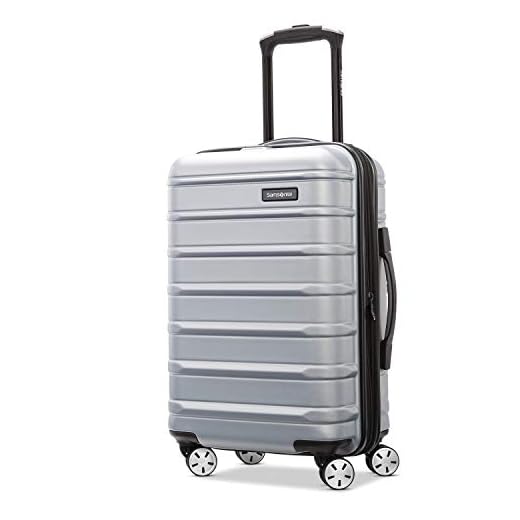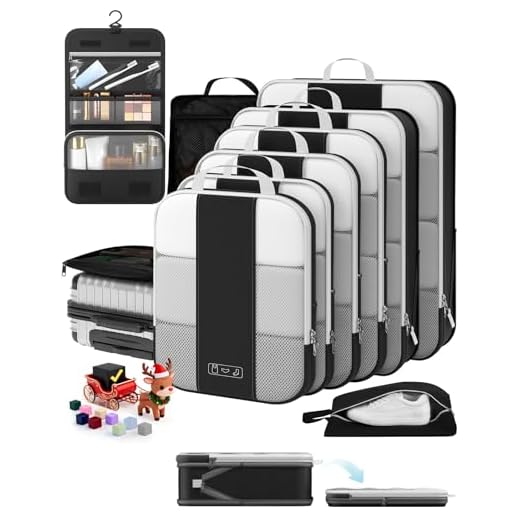






Recommendation: Choose a cabin bag with maximum external dimensions of 55 x 40 x 20 cm (approx. 22 x 16 x 8 in) to satisfy most European carriers; aim for 22 x 14 x 9 in (56 x 36 x 23 cm) when planning trips to or from US markets to maximize acceptance.
Measure width, height, depth including wheels and handles and all external pockets; carriers assess external size at check-in or gate, so allow a margin of 1–2 cm to avoid surprise fees.
Weight allowances vary: many low-cost airlines set cabin allowance at 7 kg, some legacy long-haul lines limit 8–10 kg, while several US-based carriers focus on size without explicit weight caps. Always verify published allowance on carrier website or boarding pass before departure.
Packing recommendations: use a soft-sided case with compression straps; store liquids in 100 ml containers inside a single clear resealable bag; place heavy items near wheels to stabilize bag; keep a small under-seat personal item (example 40 x 30 x 15 cm) to hold documents, electronics, valuables.
Quick checklist: measure packed case including wheels and handle; weigh ensemble on home scale; check carrier policy within 24 hours of travel; if dimensions exceed published limit, redistribute items into personal item or pre-book a checked piece to avoid gate charges.
Recommended cabin bag dimensions – overseas flights
Recommended maximum external size per most carriers: 56 x 36 x 23 cm (22 x 14 x 9 in) measured including wheels and handles; aim for a packed weight of about 8 kg (17 lb) to avoid gate-checking on stricter lines.
Measure external height from base of wheels to top of handle housing when handle is retracted; measure width at the widest point and depth at the fullest point (including wheels). When a carrier lists limits in inches, convert using 1 in = 2.54 cm and round down to avoid surprises.
| Region / Carrier type | Typical max external dims (cm) | Typical weight policy | Practical capacity |
|---|---|---|---|
| European legacy & long-haul carriers | 55 x 40 x 23 | 8–10 kg | 30–35 L (small cabin case) |
| US legacy carriers | 56 x 36 x 23 (22 x 14 x 9 in) | Often no strict published weight; recommend 7–10 kg | 35–40 L |
| Low-cost European | Small free item 40 x 20 x 25; paid cabin 55 x 40 x 20 | 7–10 kg on paid option; strict size enforcement on free small | 15–30 L |
| Asian carriers (mixed policies) | 55 x 40 x 20 or 56 x 36 x 23 | 7–10 kg typical | 30–40 L |
Quick compliance checklist: 1) Check specific carrier limits on the booking page; 2) Build a cardboard box trimmed to published dims and test fit at home; 3) Weigh packed case on a bathroom scale, shifting dense items to a checked case or under-seat item if overweight; 4) Prefer soft-sided cases when overhead bin space is tight, and use compression cubes to maximize usable volume.
Standard cabin bag dimensions (55×40×20 cm, 22×14×9 in)
Keep external measurements at or below 55×40×20 cm (22×14×9 in). That nominal envelope equals 44,000 cm³ (≈44 L); imperial run converts to roughly 45 L of external volume.
Measurement and enforcement
Always measure external size including wheels, handles and any fixed pockets; carriers verify outside dimensions at gate or boarding. Use a rigid sizer box or a tape measure and record width × height × depth as external figures.
Common policy ranges and quick checks
Many major airlines adopt the 55×40×20 cm limit; some allow depth up to 23 cm, while weight allowances typically sit between 7–12 kg or remain unspecified and enforced visually. Low-cost operators often require a smaller free item and sell a separate paid allowance for larger cabin items. Check the specific carrier policy and the departure airport rules before departure.
Packing recommendations: choose soft-sided cases to gain a few centimetres of give; use compression cubes and flat packing of electronics; place dense items at the base near the wheel block to lower the centre of gravity; keep liquids in 100 ml containers inside a clear resealable bag to meet security rules; weigh the packed case with a handheld scale to avoid gate surcharges.
Measuring height, width and depth of your bag (include wheels and handles)
Measure three dimensions precisely: height, width, depth – include wheels, feet, side handles and any protruding parts; record values in centimetres and inches and add a 2 cm (0.8 in) safety margin.
-
Prepare item
- Empty main compartment; close all zippers and fasten external straps.
- Place bag upright on a flat, level surface with wheels touching floor.
- Ensure telescopic handle is fully retracted before first measurement.
-
Height measurement
- Measure from floor to highest fixed point on bag (including wheel contact point and any molded feet).
- If telescopic handle cannot be retracted flush, measure twice: retracted and fully extended; record both numbers.
- For soft-sided bags, compress bag as you would when packing and then measure height.
-
Width measurement
- Lay bag on its back or stand upright and measure across widest external points, including side handles, pockets and any bulges.
- Measure at bag midpoint where width is usually greatest; include wheel housings if they extend beyond side shell.
-
Depth (thickness) measurement
- Measure front-to-back at deepest section, including outer pockets, front bumpers or compression straps.
- If wheels sit outside rear shell, measure from front face to outermost wheel edge.
-
Spinner and wheel specifics
- Spinner wheels: include outermost wheel edge when measuring width and depth.
- Fixed wheels: include axle and housing projection; if wheels sit within recessed wells, measure shell-to-shell.
-
Soft-sided vs hard-shell
- Soft-sided: measure twice – uncompressed and compressed; use larger figure when comparing to size limits.
- Hard-shell: measure at outermost hard points, including molded bumpers, corner guards and wheel housings.
-
Verification and documentation
- Take clear photos showing measuring tape against each dimension; save images with measurement notes.
- Keep both centimetre and inch values. Round up to next whole centimetre or half-inch when in doubt.
-
Final check
- Add 2 cm (0.8 in) allowance to each recorded dimension as safety buffer.
- If any measurement approaches a limit, re-measure with typical packed contents and with all external pockets zipped shut.
Tools checklist: flexible tape measure (metric + imperial), flat surface, notebook or phone for photos and notes, helper for taller items.
When airlines enforce size versus weight limits at boarding
Weigh and measure your cabin bag at home: aim 1–2 kg under the airline’s published weight cap and keep linear dimensions inside the permitted envelope to avoid gate check or overweight charges.
When size is most likely enforced
- Full flights with limited overhead bin space: agents measure at gate using a sizer box; items that exceed linear dimensions get tagged as gate-checked.
- Low-cost carriers: strict dimension rules apply at boarding; priority boarding holders keep a true overhead spot, others often forced to check.
- Planes with smaller cabins (regional jets, CRJs, ATRs): size enforcement rises because bins are shallower and fewer.
- Boarding groups that do not match bag distribution (late rows carrying large items): higher chance of sizer checks.
When weight is most likely enforced
- Airlines that publish cabin weight caps (commonly 7–10 kg): agents may weigh at check-in and occasionally at gate; overweight leads to check-in or fee.
- Carriers that combine cabin allowance into an overall carry-on plus personal item weight: a single scale check can force immediate reallocation or checking.
- Routes with strict safety or payload limits (small aircraft, high-altitude airports): staff may enforce weight to meet load-and-balance requirements.
Typical enforcement outcomes and financial impact:
- Gate check with no fee: common when aircraft is full but item size marginally over; bag delivered at baggage claim.
- Paid gate check or overweight fee: typical range US$25–US$150, or per-kg charges roughly US$10–US$50 where applied.
- Refusal to board with item unless checked at counter: rare, but possible when restrictions are strictly enforced.
Practical steps to reduce risk:
- Use a reliable digital luggage scale and target 1–2 kg under the posted weight cap.
- Measure linear dimensions including wheels and handles; if soft-sided, compress at seat or with straps.
- Shift dense items into a personal item worn at boarding (e.g., laptop bag) to lower cabin bag mass.
- Buy priority/early boarding when overhead space is critical; that often prevents size checks at the gate.
- If asked to gate-check, request a priority tag and keep valuables in a worn bag to speed retrieval.
- Choose compact gear: compact folding umbrella options and color guidance can help with packing; see best color for outside umbrella and specific rigging items at best umbrella rig hooks and baits.
If you dispute a measurement or weight check, ask to see the sizer diagram or scale readout, photograph the measurement, and politely request supervisor review; keep boarding group and tag numbers as evidence when submitting a claim after travel.
Cabin bag dimensions: Ryanair, EasyJet, British Airways, American, Delta
Stick to each carrier’s published maximums; measure height, width, depth with wheels and handles attached and leave 1–2 cm safety margin.
Ryanair: small personal bag 40×20×25 cm included. Priority or Plus passengers may add a larger cabin bag 55×40×20 cm, maximum weight 10 kg. Gate sizer boxes used frequently; oversized items usually checked at gate with fee applied.
easyJet: standard allowance one small under-seat bag 45×36×20 cm. Passengers with Up Front, FLEXI, or who have purchased a cabin bag option may bring 56×45×25 cm; recommended maximum weight around 10 kg. Gate staff can request bags to be measured; soft-sided bags easier to compress into sizers.
British Airways: one overhead bag 56×45×25 cm plus one personal item 40×30×15 cm. No published weight limit, but passenger must be able to lift bag into overhead bin; oversized items may be tag-checked at gate and placed in hold without refund of cabin allowance.
American Airlines: one cabin bag 22×14×9 in (56×36×23 cm) including wheels and handles plus one personal item 18×14×8 in. No standard weight limit published; size enforcement common when overhead space is limited, leading to gate check.
Delta Air Lines: one cabin bag 22×14×9 in (56×36×23 cm) including wheels/handles plus one personal item approximately 18×14×8 in. No published weight cap; gate agents may require oversized items to be checked, especially during full flights.
Practical tips: measure with bag fully packed and upright; use a soft-sided model to gain a few cm when squeezed into sizer; purchase priority/Up Front or buy a cabin bag allowance when guaranteed overhead space is needed; arrive early at gate to avoid last-minute gate check fees.
Gate options when cabin bag exceeds allowed dimensions: fees, gate-check, repack
Repack into a compliant personal item first: remove heavy electronics, rigid items and excess liquids, place valuables in a smaller bag worn on board; if repacking fails, request gate-check instead of immediately paying a high gate fee.
Typical oversize charges vary: Europe €20–€60 at gate; US domestic $25–$100 depending on route, fare class and workload; pre-paying a checked piece at the ticket counter is often cheaper than paying at the gate.
Gate-check workflow: agent measures bag with sizer, tags it as gate-checked and places tag on handle; retrieval depends on operator and aircraft type – either handed back at the aircraft door after arrival or delivered to baggage claim. Expect rougher handling than cabin bin storage.
Never gate-check valuables or essential items: passport, medication, cash, high-value cameras and spare lithium batteries must stay inside a personal item. Spare batteries are prohibited in checked hold by most regulators.
Repacking tactics with measurable impact: use compression cubes or vacuum bags to reduce volume; roll garments to save depth; shift shoes and heavy toiletries into checked suitcase or worn pockets; move laptop/tablet into a slim tote that meets personal-item dimensions.
Ask the gate agent early, immediately after boarding opens; waiting until final call reduces options and increases likelihood of a paid oversize charge. If bins are full, volunteering to gate-check may earn faster boarding or a waived fee on some operators.
Risk and liability: gate-checked items are usually processed as checked baggage under the carrier’s contract of carriage, which can limit compensation for damage or loss. Place fragile items inside protective cases or keep them with you.
Quick decision matrix: slightly over-size – repack and compress; moderate overage – request gate-check and remove valuables; large overage or prohibited contents – accept checked processing at ticket counter (often cheaper) or pay gate fee. Always verify measurements with the agent and confirm where tagged items will be returned after landing.
Packing moves to reduce onboard bag volume (compression, removable items, slim suitcases)
Compress soft garments first: vacuum bags reduce volume 40–60%; packing cubes add 10–20% usable space.
1) Roll heavy items tightly; roll plus cube yields 15–25% additional room. 2) Use internal compression straps to flatten layers and control bulge. 3) Swap bulky cotton for merino or synthetic layers that compress to ~30% of bulky equivalents.
Remove rigid or detachable elements: external battery packs, travel hair tools, removable shoe insoles, metal belt buckles. Wear bulky outerwear during boarding to free interior room.
Toiletries: decant liquids into 100 ml bottles, consolidate into single clear bag complying with security limits; freeze liquid-heavy items pre-trip to minimize leakage risk – see are satco containers ok in freezers.
Choose a slim case: target packed depth 18–20 cm; profile width under 35 cm; account for wheel height (+3–4 cm to depth). Prefer hard-shell non-expanding models or soft shells with strong internal panels and integrated compression.
Weight placement: heavier items near base or wheel end to stabilize roll; keep documents and electronics in top pocket or external sleeve for rapid security access.
Shoe strategy: limit to two pairs; stuff shoes with socks, chargers, small cables or laundry to eliminate dead space; select packable footwear that compresses 30–40% when unstructured.
Quick checklist: vacuum bag (bulk garments), packing cubes (organization), single clear toiletry bag, removable footwear, slim case with internal straps, wearable bulky items, accessible spare batteries per airline rules.







